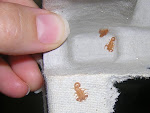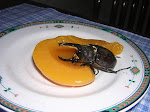The truth: cockroaches are not the slum-lords of the insect world. They aren't to blame for the filth; they just stop by to help clean it up, adding their two bits here and there. To find true ew, you have to look elsewhere. There is probably one in your home right now. They have been proven to carry more species of bacteria than a cockroach. It belongs to one of the largest orders of insects (Diptera, personally my least favorite): the House fly, Musca domestica.
 Why? How comes here this evil? House flies breed in decaying organic matter -- especially feces. As adults, they feed readily on sewage, garbage, and your lunch -- landing on all three indiscriminately. In addition, House flies have sponging mouth parts which means they can only lap up liquid. So after landing on a food source, they regurgitate to soften it, and then use their spongy labella to feed like a dog drinking water. They also defecate on their food at the same time. Lovely. With all this landing and regurgitating and crapping, the perfect storm of pathogen transfer is created. In addition to a variety of the nastiest bacteria affecting humans, the House fly may also transmit typhoid, cholera, polio and other intestinal diseases, as well as protozoan parasites such as Toxoplasma and Giardia. In essence: the House fly puts cockroaches to shame.
Why? How comes here this evil? House flies breed in decaying organic matter -- especially feces. As adults, they feed readily on sewage, garbage, and your lunch -- landing on all three indiscriminately. In addition, House flies have sponging mouth parts which means they can only lap up liquid. So after landing on a food source, they regurgitate to soften it, and then use their spongy labella to feed like a dog drinking water. They also defecate on their food at the same time. Lovely. With all this landing and regurgitating and crapping, the perfect storm of pathogen transfer is created. In addition to a variety of the nastiest bacteria affecting humans, the House fly may also transmit typhoid, cholera, polio and other intestinal diseases, as well as protozoan parasites such as Toxoplasma and Giardia. In essence: the House fly puts cockroaches to shame.Yet we shoo them away like a minor nuisance. Or go overboard and 'zap' them, spewing their guts and bacteria far and wide with greater efficiency than even they could have realized. But there is a middle ground... Fly swatters work great, as do tight-fitting window screens and closed screen doors. There are light traps (that don't zap) with sticky boards and pheromone traps of all sorts one can hang up, too. Managing breeding and feeding sources (garbage, feces, moist piles of lawn clippings) greatly helps reduce House fly numbers considering that a single female produces 75-150 eggs PER BATCH (with 5-6 batches in her life of less than a month). s Biological controls in the form of parasitic wasps, which kill fly larvae, can be released in large numbers on farms (dairies and feedlots are are often acquainted with this option).
Pesticides are not an inherent part of successful fly management. Fly strips, automatic spray dispensers, and other pesticide employments are reactive and do not address the source of the problem. Discovering and eliminating the feeding and breeding sources of House flies is cheaper in the long run, and a better investment of time.
Cockroaches are also known to carry a variety of bacteria. And they sport proteins in their exoskeletons which irritate asthmatics. But at least they're not...House flies. There's more good stuff on fly management at UC Davis.
+reduced.jpg)


2 comments:
John,
I'm sorry to hear you're having erectile issues. Even more, I'm sorry to learn that you associate said issue with a post on filthy insects. Perhaps a medical blog would be more appropriate for you...
hi
i myself quite new in this field i once again say thanks for your great info.
have a nice day
Post a Comment